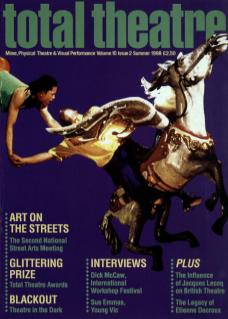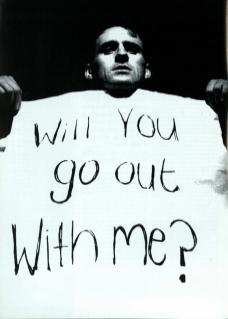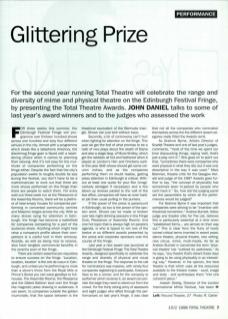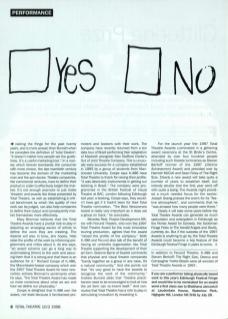For three weeks this summer, the Edinburgh Festival Fringe will programme over thirteen hundred shows across one hundred and sixty four different venues in the city. Armed with a programme which reads like a telephone directory, the discerning Fringe-goer is faced with a bewildering choice when it comes to planning their viewing. And it's not easy for the multitude of companies performing on the Fringe either. Despite the fact that the city's population swells to roughly double its size during the festival, you don't have to be a mathematician to work out that there are more shows performed on the Fringe than there are people to watch them. For every sold-out three week run at the Pleasance or the Assembly Rooms, there will be a plethora of near-empty houses for companies performing in converted community centres and Masonic lodges across the city. With so many shows vying for attention in Edinburgh, the Fringe has become a battlefield for companies competing for a part of the audience share. Anything which might help raise a company's profile above their competitors is a useful tool in their armoury. Awards, as well as being nice to receive, also have tangible commercial benefits in the piranha pool of the Fringe.
There are certain essential prerequisites to ensure success on the Fringe. 'Location, location, location' is the crie de coeur in Edinburgh, and unless you're performing no more than a stone's throw from the Royal Mile or Prince's Street you can wave goodbye to full houses. The Assembly Rooms, the Pleasance and the Gilded Balloon laud over the Fringe like magnetic poles drawing in audiences. It can seem, to companies outside the golden triumvirate, that the space between is the theatrical equivalent of the Bermuda triangle. Shows can just sink without trace.
Secondly, a bit of controversy can't hurt when fighting for attention on the Fringe. This year we get the first of what promise to be a rash of new plays about the death of Diana and also a stage biog. of Myra Hindley, which got the tabloids all hot and bothered when it played at London's Hen and Chickens earlier this year. Both shows should get some column inches, and as the companies performing them no doubt realise, getting press attention in Edinburgh is critical. Without at least one quote for your flier (imaginatively abridged if necessary) and a few blown-up reviews pasted to the wall of the box office, companies will have an even harder job than usual pulling in the punters.
If the power of the press is paramount in Edinburgh, so too is the power of the spoken word. Shows can be made or broken over late night drinking sessions in the Fringe Club, Pleasance or Assembly Rooms. And one hot topic that is always high on people's agenda, is who is tipped to win one of the twelve or so different awards presented by the press and corporate sponsors over the course of the Fringe.
Last year a new award was launched at the Edinburgh Festival Fringe: The Total Theatre Awards, designed specifically to celebrate the range and diversity of physical and visual theatre on the Fringe. The response to the call for nominations was massive, with 94 companies registering to participate. Everyone likes to be a winner, and for the company or performer which receives it, an award can provide the edge they need to stand out from the crowd. For the thirty-strong army of assessors and eight judges who sifted through the performances on last year's Fringe, it was clear that not all the companies who nominated themselves across the five different award categories really fitted the Awards remit.
As Grainne Byrne, Artistic Director of Scarlet Theatre and one of last year's judges, comments, ‘most of the time we spent our time discounting things, saying well, that's just a play isn't it’. She goes on to point out that, ‘sometimes there were companies who were physical in what they did, but it was only descriptive in the way it was used’. Mary Brennan, theatre critic for the Glasgow Herald and judge of the 1997 Awards goes further to say, ‘the concept of physicality has sometimes been hijacked by people who can't hack it’. So, how did the judging panel set the parameters by which all the performances would be judged?
For Grainne Byrne it was important that companies were striving to be ‘inventive with theatrical convention’. Andrew Burnett, fellow judge and theatre critic for The List, believes this is particularly essential at a time when ‘established forms... are almost on their way out’. This is clear from the flurry of newly coined critical terms invented in recent years: dance theatre, physical theatre, new writing, new circus, mime, multimedia. As far as Andrew Burnett is concerned the term 'physical theatre' has ‘outlived its usefulness’. As he says, ‘any theatre that's vibrant these days is going to be using physicality in an interesting way’. However, in his opinion, the best theatre is that which uses all the resources available to the theatre-maker – word, image and body – and synthesises them ‘into one coherent piece’.
Joseph Seelig, Director of the London International Mime Festival, has been visiting the Fringe for the past twenty years, and is more prosaic than Burnett when he considers the definition of total theatre': ‘it doesn't matter how people set the guidelines. It's a useful marketing tool.’ In a society which forever bombards the consumer with more choice, the late twentieth century has become the domain of the marketing man and the spin doctor. Theatre companies, like commercial ventures, have to define their product in order to effectively target the market. It's not enough anymore to just make ‘theatre’; and awards like those presented by Total Theatre, as well as establishing a critical benchmark by which the quality of new work can be judged, can also help companies to define their output and consequently market themselves more effectively.
Mary Brennan believes that the Total Theatre Awards have a pivotal role to play in assisting an emerging sector of artists to define the work they are creating. The Awards will also in time, she hopes, help raise the profile of the work by informing programmers and critics about it. As she says, ‘an award scheme can go a long way to acclimatising [them] to the work and assuring them that it is strong and that there is an audience for it’. Richard Coope of K.486, the Manchester-based company which won the 1997 Total Theatre Award for best newcomer, echoes Brennan's sentiments when he says, ‘the Total Theatre Award has made us more conscious about what we are and how we define our physicality’.
Coope is delighted that K.486 won the award, not least because it familiarised promoters and bookers with their work. The company have recently returned from a ten-date tour of Brazil performing their adaptation of Macbeth alongside Max Stafford Clarke's Out of Joint Theatre Company. This is unusually early success for a company established in 1995 by a group of students from Manchester University. Coope says K.486 have Total Theatre to thank for raising their profile: ‘it was absolutely instrumental in getting our booking in Brazil’. The company were programmed in the British Festival of Visual Theatre at BAC, London following Edinburgh last year, a booking, Coope says, they wouldn't have got if it hadn't been for their Total Theatre nomination. ‘The Best Newcomers Award is really very important as it does set a group on track,’ he concludes.
Beverley Reid, Project Development Officer with Fecund Theatre, who won the 1997 Total Theatre Award for the most innovative touring production, agrees that the award ‘raised the profile of the company’. Both K.486 and Fecund also talk of the benefit of having an umbrella organisation like Total Theatre supporting the development of their artform. Grainne Byrne of Scarlet comments that physical and visual theatre companies ‘bandy together as a group in any case, it's a natural community’. And she points out that ‘it's very good to have the awards to recognise the work of the community’. Andrew Burnett adds that ‘theatre practitioners need to be encouraged to look at how the artform can reinvent itself’. And concludes that Total Theatre has a role to play in stimulating innovation by rewarding it.
For the launch year the 1997 Total Theatre Awards culminated in a glittering award ceremony at the St Bride's Centre, attended by over four hundred people including such theatre luminaries as Steven Berkoff (winner of the 1997 Lifetime Achievement Award) and presided over by Hamish McColl and Sean Foley of The Right Size. Clearly a new award will take quite a number of years to establish itself, but nobody doubts that the first year went off with quite a bang. The Awards night provided a much needed focus for the sector. Joseph Seelig praises the event for its ‘festive atmosphere’, and comments that he ‘was amazed how many people were there’.
Clearly it will take some years before the Total Theatre Awards can generate as much speculation and anticipation in Edinburgh as the Perrier Award for Comedy, the Scotsman Fringe Firsts, or The Herald Angels and Devils, currently do. But if the success of the 1997 Awards is anything to go by, the Total Theatre Awards could become a key feature of the Edinburgh Festival Fringe in years to come.
In addition to Fecund Theatre, K.486 and Steven Berkoff, The Right Size, Derevo and Compagnie Yvette Boszik were all winners of Total Theatre Awards in 1997.



